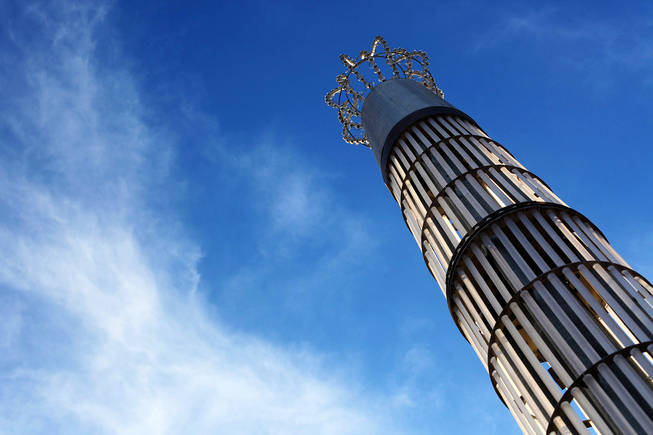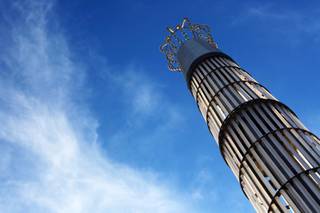
A set of sculptures called Paintbrushes by Dennis Openhein are a new addition near the Art District on Charleston in downtown Las Vegas.
Thursday, Aug. 5, 2010 | 2:01 a.m.
Sun archives
- 'Paintbrushes' arrives as Gateway to Arts District (7-29-2010)
- 'Paintbrush Gateway' erected in Arts District (7-28-2010)
- Paintbrushes? Really? (1-7-2010)
In a town that embraces outlandish architecture — medieval castle, pyramid and downsized versions of the Statue of Liberty and Eiffel Tower — and where, downtown, a Frank Gehry-designed medical building looks more sculptural than functional, there was great hope for a big statement to distinguish the downtown Arts District.
So there was some disappointment in 2007 when New York City artist Dennis Oppenheim was commissioned to create a pair of 45-foot paintbrushes for the project, known as the Gateway to the Arts District. Jutting at a slant from downtown sidewalks, the two paintbrushes — titled "Paintbrushes" — become light sculptures at night, illuminated and twinkling, and will shoot beams of light 2,000 feet into the dark sky.
Banal, detractors said at the time. Trite. Las Vegas can do better.
And now that the brushes have been erected, the divide of criticism is growing. Some celebrate the work's artistic merit, and still more say they welcome anything spectacular that's plopped downtown. The fact that Oppenheim is internationally famous for complex works in biennales, museums and galleries both irks and inspires the vocal.
Miguel Rodriguez, whose team of artists lost to Oppenheim in the selection process, says the piece will likely be well-received by the public, but he is critical of its merits. Anything that makes the Arts District more appealing is good, he agrees.
"That said, the pieces look pretty weak," he said. "If the city wanted conceptually and aesthetically pedestrian public work to distinguish the Arts District, they should have hired (sign companies). Either company could've pulled them off much better. I genuinely respect Oppenheim, but when you compare 'Brushes' with the scope of his work, they just don't hold up."
The project was controversial from the beginning when Oppenheim's approved proposal came in more than $2 million over budget and had to be presented again. Still over budget, he cut the number of brushes from four to two.
Todd VonBastiaans, who owns Alios, an architectural and entertainment lighting company in the arts district, says the project's success relies on proper programming of the LEDs. "These are living, lighting sculptures, not just sculptures that have lighting as a minor part of their execution.
"Elegant programming is easy to achieve and will make these sculptures beautiful works of art."
But Oppenheim knows this, which is why he hired local programmer Jason Goldenberg, who this week was experimenting with the more than 120 individual lights in the 45-foot brush. The brushes — one at the corner of Charleston and Casino Center boulevards and the other at Charleston and Fourth Street — can be illuminated with rhythmic color patterns. (One option being tested featured bristles flickering in rows of colors shifting to a solid blue, then moving in a wavelike pattern and finally spelling "art" in various fonts before turning into sparkling white lights.)
This is one of Oppenheim's first large works using lights. He's experimenting and willing to put his faith in the programmer.
"This is complicated with all the electrical stuff," he said, even joking that he's merely supplying the prop that's being acted upon. He says guest programmers could be invited in "like DJs."
"With public art you have to confer with others. It becomes more corporate."
The project's thrust will be the beams of light shooting upward.
"We're putting a lot of trust and hope into the coherency of the projected light — the pathway into the darkness, the unknown," he says. "There is a lot of mystique. Art is largely mystique as a discipline, but I don't want to be too poetic."
He's aware of the critics, but shrugs them off.
"Requirements bearing down on some public artwork stifle the imagination," he said. "But if it's too placated, watered down, then it ceases to be pertinent as art. Because of this compromise, public art, for a long time, has been considered low-grade art. Art can be truly strange if you're free enough to allow that."
Looking at the brush, he says, "This is not satirical. This is what it is."
A version of this story appears in the current issue of Las Vegas Weekly, a sister publication of the Sun.


Join the Discussion:
Check this out for a full explanation of our conversion to the LiveFyre commenting system and instructions on how to sign up for an account.
Full comments policy